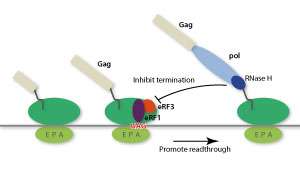Blocking mechanism used by a mysterious class of retroviruses to force hosts to allow them to replicate

Viruses hijack a body's cellular machinery for their own reproduction. Scientists have shown how one class of virus uses a trick to override natural signals that would otherwise stop them from replicating.
Researchers from the A*STAR Institute of Molecular and Cell Biology have identified the mechanism through which one such virus—Moloney murine leukemia virus (MMLV)—is able to effectively ignore the RNA messages known as 'stop-codons', which tell the body to stop translating genetic code into proteins.
The project's lead researcher, Haiwei Song, explained that MMLV is one of a family of retroviruses, a type of virus that can insert itself into host DNA to replicate.
"MMLV belongs to the gammaretroviruses, one genus of retroviruses recently implicated in human diseases," he says. But, the exact role of gammaretroviruses in causing disease remains mysterious.
In 2006 the gammaretrovirus XMRV was identified in samples from men with prostate cancer.
Some studies have found murine leukemia virus (MLV), as well as XMRV, occurs at much higher rates in people with chronic fatigue syndrome than in healthy controls, however others have not found this difference.
"We don't know the potential role of XMRV and MLV in causing diseases such as prostate cancer and chronic fatigue syndrome, and the frequency of gammaretrovirus infection among healthy people," Song says. But, a link common to all retroviruses is their ability to ignore RNA stop-codons.
"Without this ability, the retroviruses will simply not survive," Song says. "So it is a very important target for antiviral intervention."
Identifying the mechanism gammaretroviruses use to ignore stop-codons could lead to new treatments, Song says.
MMLV contains the enzyme reverse transcriptase that allows its RNA to be converted to DNA in the host. Song's research shows that this enzyme binds to a protein (peptidyl release factor 1) in its host that would otherwise be responsible for reading the stop-codons. This thwarts its ability to bind and prevents it from working.
The research also provides insight into the workings of the world's most notorious retrovirus, human immunodeficiency virus (HIV).
It was previously believed that a reverse transcriptase interaction would be common across all retroviruses. However, Song and his team found that the HIV reverse transcriptase did not bond to peptidyl release factor 1.
"This means that any anti-gammaretrovirus interventions would not work on HIV," Song says.
More information: Xuhua Tang et al. Structural basis of suppression of host translation termination by Moloney Murine Leukemia Virus, Nature Communications (2016). DOI: 10.1038/ncomms12070
Journal information: Nature Communications

















